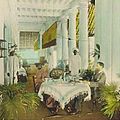Domestic worker facts for kids
A domestic worker is someone who works inside a home. They help with tasks like cleaning, cooking, and looking after children. Many domestic workers even live in the homes where they work. Long ago, especially in the 1800s, many families in Europe and the United States had domestic workers.
Domestic workers are paid for their jobs. They are free to choose where they work. Sometimes, employers ask domestic workers to wear a uniform while working.
Contents
Domestic Workers in History
In the Victorian era in Britain, many people worked as domestic helpers. The most important male worker was often the butler. He was like a head waiter during meals. Other male workers were sometimes called "valets". A valet was a personal helper. They might look after their master’s clothes and personal needs.
Female domestic workers were usually maids. Maids cleaned the house. Cooks prepared the meals. Nannies looked after the children. Gardeners took care of the gardening.
In the early 1900s, Britain made new laws. These laws helped protect domestic workers. They gave them more rights. Long ago, in the 1700s, even some musicians were like servants. They had to wear special uniforms. For example, in 1717, the famous composer Johann Sebastian Bach wanted to leave his job. The duke he worked for actually put him in prison for a short time. This shows how few rights workers had back then.
Protecting Domestic Workers Today
Today, many domestic workers come from poorer countries. They often work for families in richer countries. To make sure all domestic workers have fair jobs, the International Labour Organization created a special agreement. It is called Convention No. 189 on domestic workers. This agreement helps protect their rights. It includes rights for migrant workers too.
Related pages
Images for kids
-
Memorial valuing the work of Maria Home, the servant in Warwick Castle (1834)
-
A Han Dynasty (202 BC – 220 AD) Chinese ceramic figurine of a lady's maid in a standard formal pose with hands covered by long sleeve cuffs in the traditional fashion
-
Child maid servant in India. Child domestic workers are common in India, with the children often being sent by their parents to earn extra money, although it is banned by the government.
-
Alipin (Slaves/Indentured Servants) in Pre-colonial Philippines: Visayan uripon, as depicted in the Boxer Codex (c. 1590)
-
The Chocolate Girl, by Jean-Étienne Liotard (c. 1734–1744)
-
Colonial dining, William Henry Jackson (1895)
See also
 In Spanish: Trabajador doméstico para niños
In Spanish: Trabajador doméstico para niños



















